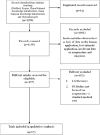Acupuncture Versus Standard Medical Care in the Prophylactic Treatment of Migraine: A Systematic Review and Meta-Analysis
- PMID: 40237227
- PMCID: PMC12000925
- DOI: 10.1111/ene.70160
Acupuncture Versus Standard Medical Care in the Prophylactic Treatment of Migraine: A Systematic Review and Meta-Analysis
Abstract
Background: Although innovative pharmacological therapies for migraine prevention are now available, they may not be suitable or effective for all patients due to concerns about tolerability and the varying complexity of the underlying condition. This study systematically reviewed and meta-analyzed acupuncture's effects on migraine prophylaxis compared to standard medical care, focusing on study heterogeneity and issues related to sham interventions.
Methods: Following the PRISMA guidelines and using the PICO model, the study searched PubMed, Scopus, CNKI, and VIP database from December 1965 to September 2024. Studies evaluating acupuncture's clinical efficacy for migraine prophylaxis, including clinical trials, observational studies, case series, and case reports, were considered. An additional search was conducted on the clinicaltrials.gov database from the beginning of indexing up to September 2024 to include ongoing studies. Quality control and bias assessment were performed. Primary outcomes focused on acupuncture's efficacy and safety versus pharmacological treatments in reducing migraine frequency and intensity. The impact on patients' quality of life was also evaluated.
Results: At the end of the selection process, 15 studies were eligible. Acupuncture showed no statistically significant difference as a prophylactic treatment for migraine in reducing the frequency of migraine days or pain intensity but did reduce the use of analgesics while improving patients' quality of life.
Conclusion: Current evidence supports acupuncture as an adjunctive therapy in migraine prophylaxis, but challenges such as protocol heterogeneity, dropout biases, the complexities of sham-controlled trials, and the lack of comparison data with newer innovative treatments not yet considered warrant further research.
Keywords: acupuncture; migraine; prophylaxis; quality of life.
© 2025 The Author(s). European Journal of Neurology published by John Wiley & Sons Ltd on behalf of European Academy of Neurology.
Conflict of interest statement
The authors declare no conflicts of interest.
Figures





References
Publication types
MeSH terms
LinkOut - more resources
Full Text Sources
Medical

